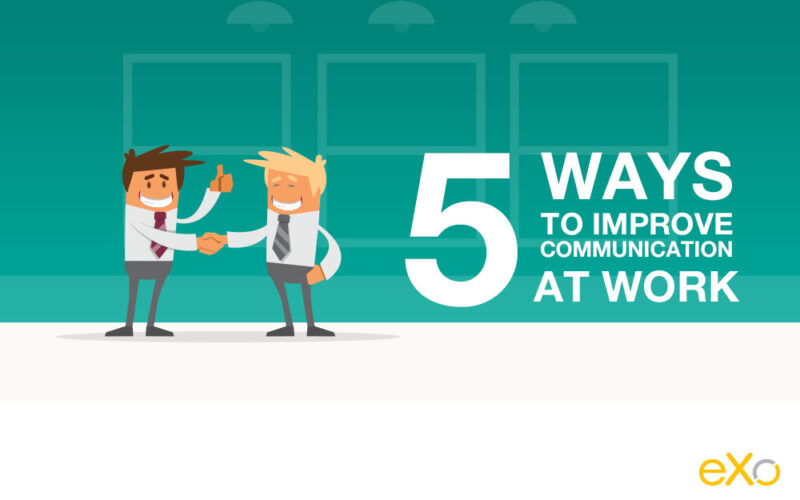- Veronika Mazour
- September 29, 2016
5 Ways to Improve Communication at Work
Optimal communication in the workplace is paramount to a successful business. But in our digital era, work communication is also evolving and becoming more challenging.
In particular, we now face three new challenges in business communication.

Content
First, there is so much information that we are all in overdrive most of the time. Second, our attention spans are shorter than before, and we are constantly asked to multitask. Finally, we can use a multitude of communication channels, whereas we had unique human interactions before. So how do we get the message across in the workplace? In a nutshell, it all comes down to expressing the message as briefly and efficiently as possible and choosing the right channel to communicate it.
Below is our list of ways to improve communication at work, compiled from advice from communication experts and our expertise in digital collaboration .
1. Get straight to the point
When communicating a message at work, be as direct and concise as possible. While this has always been sound advice, getting straight to the point is a necessity today. With each passing minute, your listener’s attention diminishes. If you do not make your point fast, you might not be able to.
2. Lead with your headline
If you have several arguments that lead to a conclusion, support a claim, or justify an idea, start with the conclusion rather than with the logical progression of your argument. At best, you will get more attention and interest, and at worst, you will at least get your main idea across.
3. Listen
Listening is a great way to improve communication quality at work. By listening to others, we learn the best way to get our messages across to a variety of people and understand differences in opinions. Of course, a better listening climate, in which the atmosphere is relaxed and the gadgets are hidden, leads to a healthier communication climate.
If your workplace is like most , chances are that most people talk more than they listen. Be different.
4. Cut the parasites
Do we only communicate at work about work with some occasional socializing? Probably not. A good way to improve communication at work lies in refusing to gossip about colleagues. It is a waste of everyone’s time, and it tends to create conflicts.
The same is true for aggressive communication, which is very common in some workplaces.
5. Choose the right communication channel
Not too long ago, we relied solely on communicating in person, by phone, and, very occasionally, by letter. The choice of channels was evident and dictated by distance and time constraints. In today’s workplaces, where several channels compete for attention, a balance between disruption and efficiency must be found. Below is a guide to choosing channels to obtain the optimum balance.
In person
Negative messages need to be delivered in person because any other channel distorts the communication by hiding subtleties of facial expression, body language, voice tone, etc.
Of course, it would be a pity to limit in-person communication only to negative news. Social interactions should be held in person as well. If possible, get to know some of your coworkers personally. This is nice on its own, but it will also improve the efficiency of all the other channels .
Email was first invented to instantly deliver letters, before it escalated to the time-consuming machine we all face every day. It is the most efficient way of communicating when the discussion is private and not urgent.
Avoid group emails with endless threads and forwards. In addition, avoid urgent emails—chances are they will get buried under other messages.
Social streams
Social collaboration tools and enterprise social networks have become common in workplaces. They are best used for non-urgent group discussions. They are also an excellent way to inform a group of people about something.
Chat and video conferencing
Chat and video are best for urgent discussions when a quick answer is necessary from one or several people. These channels are also best when you need to communicate using visual aids. Sometimes you can save an hour of your time by showing your screen or a presentation to someone in real time. Make sure to use a subtitle generator so that your video includes captions for hearing impaired team members.”
Phone
Phone calls are a decent replacement for personal interaction when such interaction is impossible for any reason.
This is also the best channel for urgent one-on-one questions or when you need to direct someone’s attention to an email, a post, etc.
Text message
Because texts are short, they are not very well suited for work communication. Most people use texts primarily for personal communication, and they feel that their texts are private. They are also used less for advertising.
For all those reasons, use texts sparingly as a follow up to get someone’s attention and stay on top of their priority list.
Letter
Physical letters are considered old-fashioned. They are more clearly less suited for work communication than any other channel. As a result, people receive fewer letters than before, and most of us welcome the change.
However, letters or written notes are an excellent way to say thank you or send someone good wishes or condolences.
- Tags: Digital workplace, Collaboration
Rate this post
I am the Chief Executive Officer of eXo Platform (the open source digital workplace platform), a company that I co-founded while in college and that I came back to after several years in the banking and consulting industry. I blog about modern work, about open-source and sovereignty issues. Occasionally, I also blog about my personal areas of interest, such as personal development, work–life balance, sustainability and gender equality.
Related posts
- All
- eXo
- Digital workplace
- Employee engagement
- Open source
- Future of work
- Internal communication
- Collaboration
- News
- intranet
- workplace
- Knowledge management
- Employee experience
- Employee productivity
- onboarding
- Employee recognition
- Change management
- Cartoon
- Digital transformation
- Infographic
- Remote work
- Industry trends
- Product News
- Thought leadership
- Tips & Tricks
- Tutorial
- Uncategorized
Leave a Reply
( Your e-mail address will not be published)
Connexion
0 Comments
Commentaires en ligne
Afficher tous les commentaires


